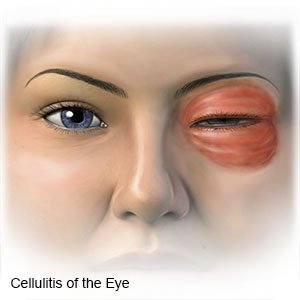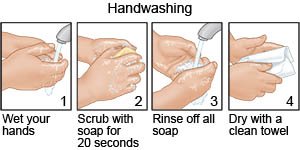Periorbital Cellulitis in Children
Medically reviewed by Drugs.com. Last updated on Apr 6, 2025.
What is periorbital cellulitis?
Periorbital cellulitis, or preseptal cellulitis, is a bacterial infection of your child's eyelid or the skin around his or her eye. The infection can develop from a scratch or insect bite around the eye. Periorbital cellulitis may cause vision problems. It should be treated as soon as possible to prevent complications.
 |
What are the signs and symptoms of periorbital cellulitis?
Signs and symptoms are usually seen on one eye. Your child may have any of the following:
- Red, warm, swollen eyelid
- Trouble opening the eye
- A fever
- An eyelid that feels warm and hard
- Pain or tenderness when the area is touched
- Drainage from your child's eye
How is periorbital cellulitis diagnosed?
Your child's healthcare provider will examine your child's eye. He or she will test your child's eye movement and vision. Your child may need blood tests to show what kind of bacteria are causing the infection. Other tests may be needed to see if the infection has spread.
How is periorbital cellulitis treated?
- Antibiotics help treat a bacterial infection.
- Acetaminophen decreases pain and fever. It is available without a doctor's order. Ask how much to give your child and how often to give it. Follow directions. Read the labels of all other medicines your child uses to see if they also contain acetaminophen, or ask your child's doctor or pharmacist. Acetaminophen can cause liver damage if not taken correctly.
- NSAIDs , such as ibuprofen, help decrease swelling, pain, and fever. This medicine is available with or without a doctor's order. NSAIDs can cause stomach bleeding or kidney problems in certain people. If your child takes blood thinner medicine, always ask if NSAIDs are safe for him or her. Always read the medicine label and follow directions. Do not give these medicines to children younger than 6 months without direction from a healthcare provider.
How can I manage my child's symptoms?
- Help your child wash the area with soap and water every day. Gently pat dry. Use bandages if directed by your healthcare provider.
- Remind your child to not rub or scratch his or her eye. This can increase your child's risk for spreading the infection.
- Place a cool, damp cloth on your child's eye. Use clean cloths and clean water. You can do this as often as you need to. Cool, damp cloths may help decrease pain.
- Have your child wash his or her hands often. Make sure he or she washes with soap and water after using the bathroom or sneezing. He or she also needs to wash his or her hands before eating. Use lotion to prevent dry, cracked skin.

How can another eye infection be prevented?
- Have your child wear proper safety equipment. Protect your child's face from injury during sports and other activities.
- Keep wounds clean and dry. Clean wounds on your child's face with soap and water. Cover wounds with a dry bandage if needed.
When should I seek immediate care?
- Your child says his or her neck feels stiff.
- Your child has a headache and is vomiting.
- Your child has blurred or double vision and cannot see well in bright light.
- Your child's infected eye bulges from his or her head.
- You see red streaks coming from the infected area.
When should I call my child's doctor?
- Your child has a fever higher than 101.5°F (38.6°C) and chills.
- The red, warm, swollen area gets larger.
- Your child's fever or pain does not go away or gets worse.
- You have questions or concerns about your child's condition or care.
Care Agreement
You have the right to help plan your child's care. Learn about your child's health condition and how it may be treated. Discuss treatment options with your child's healthcare providers to decide what care you want for your child. The above information is an educational aid only. It is not intended as medical advice for individual conditions or treatments. Talk to your doctor, nurse or pharmacist before following any medical regimen to see if it is safe and effective for you.© Copyright Merative 2025 Information is for End User's use only and may not be sold, redistributed or otherwise used for commercial purposes.
Learn more about Periorbital Cellulitis
Treatment options
Care guides
Further information
Always consult your healthcare provider to ensure the information displayed on this page applies to your personal circumstances.
